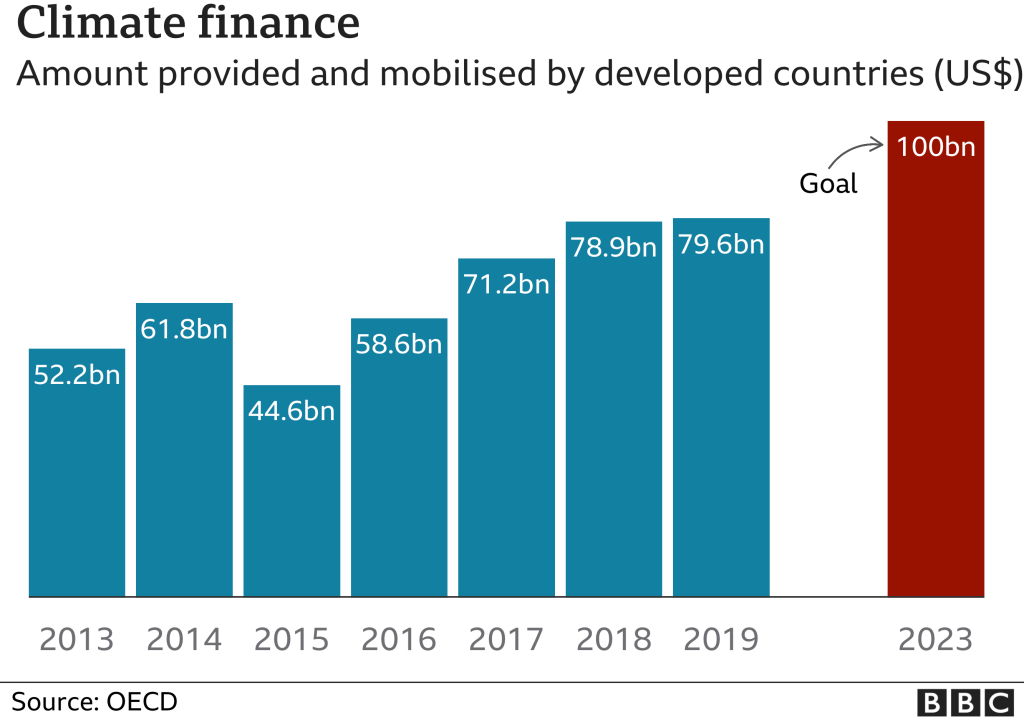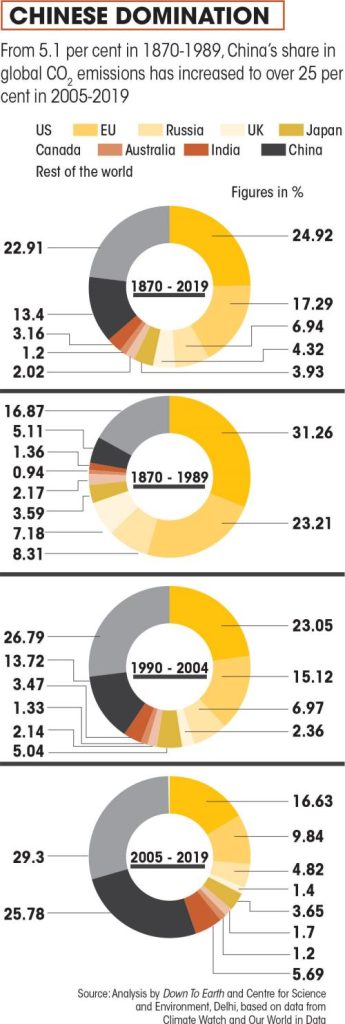Context:
- Environment Minister Bhupender Yadav throwed light on what would be India’s viewpoints as he leaves to Glasgow to participate in the 26th edition of the United Nations Conference of Parties (COP).
- Prime Minister Narendra Modi will be participating in a World Leaders Summit to be held next week as part of the COP.
Relevance:
GS-III: Environment and Ecology (Conservation of the Environment, International Treaties and Agreements), GS-II: International Relations (India’s neighbors, Foreign Policies affecting India’s Interests)
Dimensions of the Article:
- What is Conference of Parties (CoP)?
- Background: What is the Paris Agreement?
- What does COP26 aim to achieve and what is its Significance?
- Which countries have submitted new NDCs?
- India likely to update climate NDC ahead of COP26
- What has the Environment Minister said about India’s agenda at COP26?
- Why China matters at Glasgow?
Click Here to read about Conference of Parties (CoP), COP26 and its goals and Kyoto Protocol
Background: What is the Paris Agreement?
- The Paris Agreement is an international treaty signed by almost all countries in the world at COP21 in Paris in 2015.
- Its aims are to keep the rise in the global average temperature to ‘well below’ 2 degrees above pre-industrial levels, ideally 1.5 degrees; strengthen the ability to adapt to climate change and build resilience; and align all finance flows with ‘a pathway towards low greenhouse gas emissions and climate-resilient development’.
- The Paris Agreement has a ‘bottom-up’ approach where countries themselves decide by how much they will reduce their emissions by a certain year. They communicate these targets to the UNFCCC in the form of ‘nationally determined contributions’, or ‘NDCs’.
What does COP26 aim to achieve and what is its Significance?
Implementation of the Paris Agreement:
- At COP26, parties also need to try and finalize the Paris Agreement’s ‘implementation guide’ – the Paris Rulebook.
- Agreeing on what rules should govern international carbon markets – the ‘Article 6 negotiations’ – is expected to be particularly difficult.
1.5-degree target is still possible, there’s still hope:
- The 2021 Intergovernmental Panel on Climate Change (IPCC) report underscores the it is still possible to achieve the 1.5-degree-target.
- Hence, COP26 is a critical summit for global climate action to have a chance of limiting warming to 1.5 degrees.
- The difference between 1.5 and 2 degrees of global warming is substantial: every increment of a degree translates into increased risks for people, communities, and ecosystems.
Raising Ambition levels of NDCs:
- The Nationally Determined Contributions (NDCs) submitted in 2015 were collectively not ambitious enough to limit global warming to ‘well below’ 1.5 degrees.
- Hence, as the signatories of the Paris Agreement are expected to submit new and more ambitious NDCs every five years (known as the ‘ratchet mechanism’) – COP 26 becomes important as the first test of this ambition-raising function.
Meeting Financial commitments:
- The official figures for 2020 will not be available until 2022, but it is clear the goal was not met in 2020.
- A successful outcome in Glasgow also requires developed countries to honour a promise they made back in 2009 of mobilizing $100 billion per year by 2020 to support climate action in developing countries.
- Recent announcements, including President Joe Biden’s pledge to double US climate finance, have brought developed countries closer to honouring the pledge, but more will need to be done to restore credibility and strengthen trust between developing and developed nations.

Ability to adapt to climate change:
- The question of how to deal with economic and non-economic harms caused by climate change impacts which cannot be avoided through adaptation or mitigation – known as ‘loss and damage’ is another important element of COP26.
- Discussions on the issues with ‘strengthening the ability to adapt to climate change impacts’ – often focus on mobilizing finance.
- However, it is also important that parties make progress on other issues such as further operationalizing the Paris Agreement’s ‘global goal on adaptation’ which, at present, is vaguely formulated.
Which countries have submitted new NDCs?
- As of September 2021, 86 countries and the EU27 have submitted new or updated NDCs to the UNFCCC.
- A few governments, like China and Japan, have pledged new 2030 targets but are yet to submit them officially.
- Some of the new NDCs are in the upper limits of what many had expected.
- The UK has, for instance, pledged to reduce emissions by 68 per cent by 2030 compared to 1990 levels, and 78 per cent by 2035. The European Union (EU) is aiming for a reduction of at least 55 per cent by 2030 relative to 1990 levels, and the US target is ‘a reduction of 50-52 per cent’ compared to 2005 levels.
- However, the NDC updates only narrow the gap to 1.5 degrees by 15 per cent at most.
- Around 70 countries are yet to communicate new or updates targets. And several – Australia, Brazil, Indonesia, Mexico, New Zealand, Russia, Singapore, Switzerland and Vietnam – have submitted without raising ambition.
India likely to update climate NDC ahead of COP26
- India’s present NDC submitted in 2015 consists of three main elements —
- An economy-wide emissions intensity target of 33% to 35% below 2005 levels,
- Electric power capacity target of 40% installed capacity from non-fossil-based energy resources by 2030 (conditional to international support), and
- Creating a carbon sink expansion target of creating an additional (cumulative) carbon sink of 2.5–3 billion tonnes through additional forest and tree cover by 2030.
- India’s non-fossil fuel installed power capacity at 153.88 GW is already almost 40% of the total installed capacity – indicating that India is likely to exceed one of the elements of its NDCs.
- India has already achieved a drop of 24% in the emissions intensity of its GDP compared to 2005 levels.
- “India will install 450 gigawatts (GW) of renewable energy by 2030” – Prime Minister Narendra Modi had reiterated on September 2021 session of the United Nations General Assembly.
- Hence, there are talks of announcing a slightly updated target taking into account our commitments on renewable energy at COP26 according to an official at the environment ministry.
What has the Environment Minister said about India’s agenda at COP26?
- The points of discussion will be the assistance that developing countries such as India need for:
- Mitigating carbon emissions,
- Adapting to a warming world, and
- Insisting on a firm, transparent framework that lays out how this can be met.
- The 26th COP is expected to be fractious with many developed countries, led by the United States, to push for a deadline by which all countries agree to cease net carbon dioxide emissions.
- India is among the major emitters, the third largest in the world, to not have indicated any deadline or even a tentative pathway towards such a “net zero”’ goal. China and the United States, the other two major polluters have indicated 2060 and 2050 as potential deadlines for capping their net emissions.
- India has on several fora resisted being forced to commit to such a deadline on the grounds that it violates agreed-upon principles of climate justice that require countries to have “differential responsibilities” to addressing the climate crisis.
Why China matters at Glasgow?
Increase in China’s Emissions
- Till the early 2000s, the US, EU, UK, Russia, Australia, Canada and Japan dominated global emissions. But this has changed significantly from the time China joined the World Trade Organization and became the factory of the world.
- By 2005, China’s carbon dioxide (CO2) emissions surpassed the US and the country is currently the world’s largest emitter.
- Between 1990 and 2019, China increased its share of global CO2 emissions from 5% to 20%. In 2019 alone, it emitted roughly 28% of the world’s emissions.
- China’s rapid growth is visible in terms of the fact that it has exceeded emissions of the other developed countries in a matter of two decades or so.
- By comparison, the historical emitters had over a century to reach this level. On cumulative terms, however, China’s contribution is lower than the other historical polluters.
- In terms of per capita emissions, China emitted 10.5 tonnes in 2019 — five times that of India’s meagre 1.9 tonnes of per capita CO2 emission. This is despite the fact that both the countries have a comparable population.

Issues with China’s NDC
- China’s official NDC (Nationally Determined Contribution), submitted in Paris in 2016, is based on a carbon intensity target. In September 2020, President Xi Jinping announced that China will “aim to have CO2 emissions peak before 2030 and achieve carbon neutrality before 2060”.
- Because it has not set a quantifiable target for reduction — its Nationally Determined Contribution (NDC) is based on carbon intensity reduction — its emissions are expected to continue to grow in this decade.
- The country still runs over half of the world’s operating coal fleet, which is growing. China’s total installed coal capacity is estimated at 1,050 GW in 2020, half of the global total. In 2020, China put another 38.4 GW of new coal-fired power capacity into operation — more than three times the amount that is being built elsewhere around the world.
- And so, despite all the talk about China’s renewable energy, it is still dependent on coal for power — 60.75 per cent of its electricity came from coal in 2020 while 20.02 per cent came from low-carbon sources like solar, wind and hydropower. (Note: India’s non-fossil energy generation capacity is in fact higher than that of China.)
- In terms of domestic renewable energy, China has an installed capacity of 253 GW of solar energy and 288 GW of wind energy by 2020. According to China’s NDC, the plan is to augment the capacity to 1,200 GW by 2030, as against India’s plan for 450 GW by 2030.
- China will also be in the forefront to supply the world with clean energy technology and in this way benefit from the climate mitigation efforts of the world – as China has made massive investments in renewable energy and electric vehicles and surpasses all other countries in production capacity.
- Despite its lofty renewable energy plans, China’s goal for carbon neutrality will be unachievable unless it curbs its growing coal power production.
-Source: The Hindu, Indian Express, Down to Earth Magazine



